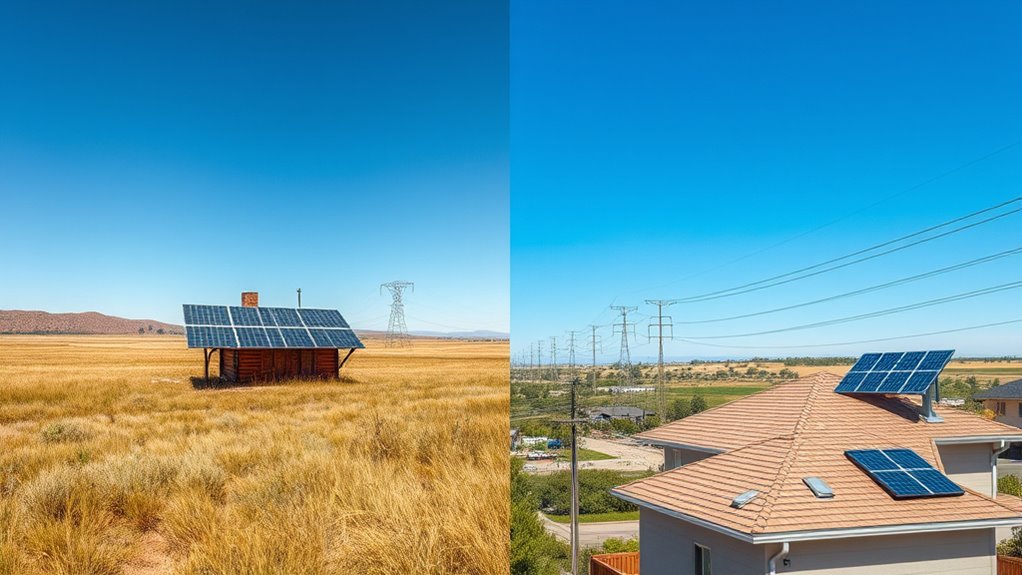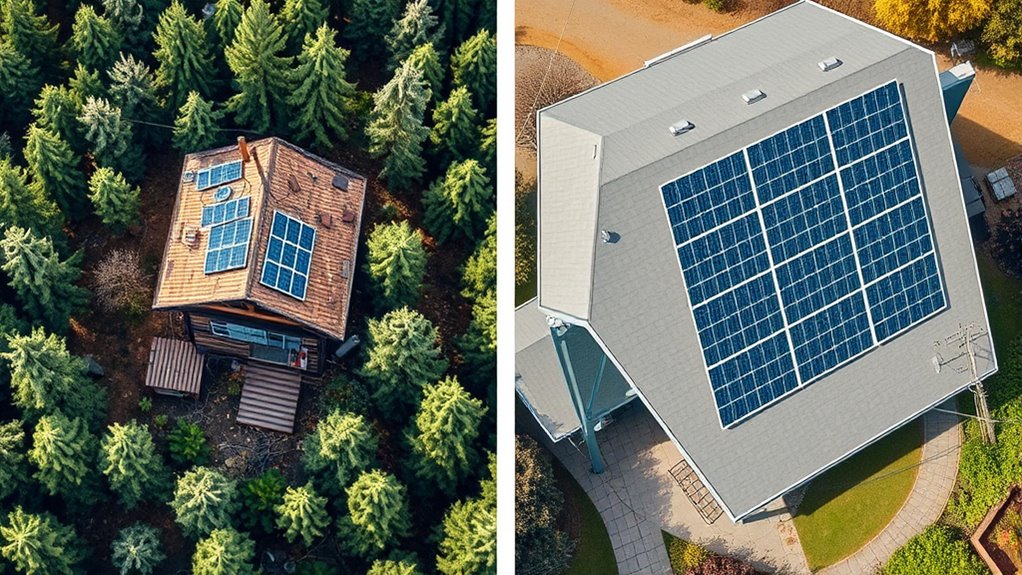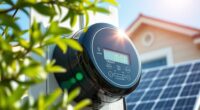If you’re choosing between off-grid and grid-tied solar systems, you’ll notice key differences. Off-grid setups operate independently, relying on batteries and renewable energy, perfect for remote locations and aiming for full independence. Grid-tied systems connect to the main power grid, offering lower upfront costs and easier expansion, but depend on grid stability. To understand which option fits your needs, explore the details behind costs, storage, and environmental benefits next.
Key Takeaways
- Grid-tied systems connect to the main grid, enabling energy sharing and lower upfront costs; off-grid systems operate independently with storage solutions.
- Off-grid setups require larger batteries and higher initial investment to ensure continuous power; grid-tied systems rely on the grid for backup.
- Grid-tied systems are easier to scale within existing infrastructure; off-grid systems offer modular expansion tailored to remote or off-grid locations.
- Off-grid systems emphasize renewable energy, sustainability, and ecological impact reduction; grid-tied systems focus on integration with existing energy infrastructure.
- Off-grid systems provide complete energy independence, ideal for remote areas; grid-tied systems support centralized power use and grid support.
System Connectivity and Power Supply

When it comes to system connectivity and power supply, the key difference lies in how each system interacts with the grid. With a grid-tied system, you’re directly connected to the grid, making remote monitoring straightforward and allowing your system to draw power when needed. This setup reduces grid dependency, as you can rely on the grid during low sunlight or high demand. Off-grid systems, however, operate independently, meaning you’re not connected to the grid at all. You must generate all your power on-site, often with solar panels and batteries. This independence requires careful planning to ensure a consistent power supply without external support. While grid-tied setups offer flexibility and easier management, off-grid systems demand a more self-reliant approach, controlling your power source entirely. Incorporating wall organization systems can help optimize space and keep essential components organized in your off-grid setup. Additionally, understanding energy storage solutions is crucial for maintaining reliable power in off-grid configurations. Proper system sizing ensures your setup can meet your energy demands consistently, especially in off-grid scenarios, and considering power management techniques can further enhance system efficiency and longevity. Moreover, integrating energy-efficient appliances can significantly reduce the overall load on your off-grid system, making it more sustainable and cost-effective.
Energy Storage and Battery Use

Energy storage and battery use play a vital role in how off-grid and grid-tied systems manage their power. Your battery capacity determines how much energy you can store for later use, especially during cloudy days or at night. Off-grid systems typically require larger batteries with higher storage options to guarantee continuous power independent of the grid. Grid-tied systems often use smaller batteries or rely on the grid itself as a backup, reducing storage needs. Your choice of storage options impacts system reliability and flexibility. Properly sized batteries allow you to maximize solar energy use and minimize reliance on external sources. battery capacity is a crucial factor in ensuring your system’s efficiency and resilience. Additionally, understanding storage efficiency helps optimize how effectively your batteries utilize and retain energy, further enhancing your system’s performance. Effective energy management strategies can also improve overall system longevity and cost-effectiveness. Ultimately, understanding your energy storage needs helps you select the right batteries and storage solutions for your specific system type.
Cost Considerations and Investment

Cost considerations and initial investment are essential factors in choosing between off-grid and grid-tied systems. A thorough cost comparison reveals that grid-tied setups typically require lower upfront expenses because they leverage existing grid infrastructure, reducing the need for large batteries and backup systems. Off-grid systems, however, demand a higher initial investment due to the necessity of batteries, charge controllers, and larger solar arrays to ensure independence. While off-grid systems may seem costlier upfront, they offer long-term savings by eliminating ongoing grid connection fees. Additionally, understanding the refrigeration cycle can be useful when considering energy-efficient appliances to reduce overall power consumption. Proper system sizing and energy management strategies are crucial for maximizing efficiency and minimizing costs over the system’s lifespan. Properly managing battery storage and system components can also help optimize performance and longevity of the off-grid setup. A well-designed system can mitigate energy losses and enhance overall efficiency, making the investment more worthwhile. For example, selecting appropriate inverter technology can significantly improve energy conversion efficiency. Conversely, grid-tied systems often have lower initial costs but may incur additional expenses if power outages or grid charges arise. Your choice hinges on balancing your initial budget with long-term financial and energy independence goals.
Maintenance and System Management

Maintaining and managing off-grid and grid-tied systems require different approaches to guarantee peak performance. Off-grid setups demand regular inspections and proactive system troubleshooting since you’re responsible for all components. Remote monitoring plays a crucial role, allowing you to check system health remotely and detect issues early. Grid-tied systems benefit from automatic grid support and less frequent maintenance, but troubleshooting may require specialized knowledge of grid interactions. To illustrate, here’s a comparison:
| Aspect | Off-Grid | Grid-Tied | Shared Point |
|---|---|---|---|
| Maintenance Frequency | Higher due to isolated setup | Lower, grid supports system | Both need regular inspection |
| Troubleshooting | Manual, on-site | Can involve utility assistance | Critical for system reliability |
| Remote Monitoring | Essential for early detection | Useful but less critical | Enhances system management |
| System Repairs | May be complex and costly | Generally simpler | Both require prompt attention |
| System Updates | More frequent, manual updates | Less frequent, automated | Ensures crucial performance |
Additionally, understanding system components and their maintenance needs is vital for ensuring long-term system performance. Proper maintenance also involves keeping an eye on battery health, which is especially important for off-grid systems relying on energy storage to ensure reliability. Regular component inspections help prevent unexpected failures and extend the lifespan of your system. Moreover, staying informed about professional support options can be beneficial when complex issues arise. Recognizing performance upgrades can lead to more efficient system operation over time.
Environmental Impact and Sustainability

Choosing between off-grid and grid-tied systems substantially influences your environmental footprint. Off-grid systems often prioritize renewable sourcing, utilizing solar, wind, or other clean energy sources to reduce reliance on fossil fuels. This approach significantly diminishes greenhouse gas emissions and promotes sustainability. Additionally, off-grid setups typically incorporate recycling practices, such as repurposing batteries and components to extend their lifespan and reduce waste. Many off-grid systems also emphasize sustainable materials in their construction to lessen environmental impact. Incorporating alternative energy sources can further enhance the eco-friendliness of off-grid solutions. These strategies are supported by the broader private equity market’s focus on ESG factors, encouraging environmentally responsible investments. Off-grid systems can also be designed to optimize energy efficiency, reducing overall consumption and waste. Furthermore, implementing environmentally friendly recycling practices helps minimize the ecological footprint of energy systems. Grid-tied systems, while connected to the main power grid, can still support sustainability when paired with renewable energy sources, but they rely more on centralized energy production, which may involve fossil fuels. Overall, your choice impacts how much you contribute to environmental preservation, emphasizing the importance of selecting systems that maximize renewable sourcing and environmentally friendly recycling practices.
Flexibility and Scalability

Both off-grid and grid-tied systems offer varying degrees of flexibility and scalability, which can substantially influence your long-term energy management. Off-grid setups often feature modular expansion, allowing you to add more batteries or panels as your energy needs grow. Grid-tied systems, on the other hand, integrate seamlessly with existing infrastructure, making system integration straightforward and adaptable. Your choice depends on whether you want the ability to expand independently or prefer a system that easily scales with grid enhancements. Keep in mind that modular expansion is more accessible in off-grid systems, while scalability in grid-tied systems relies on grid capacity and utility policies. Additionally, understanding the nutritional advantages of green juice can be an analogy for how flexible systems can adapt to changing needs.
Optimal Use Cases and Ideal Users

Off-grid systems are ideal for remote locations or users seeking complete energy independence, where grid access is unavailable or unreliable. They’re perfect if you want backup power during outages or in areas with frequent service disruptions. Off-grid setups work well for cabins, farms, or off-the-beaten-path homes, providing autonomy from utility grids. Additionally, many regions offer government incentives that can offset installation costs, making off-grid systems more affordable. If you’re motivated by sustainability or independence, these systems suit you best. Keep in mind, though, they require careful planning for energy storage and consumption. Off-grid systems aren’t just for remote users—they’re also a smart choice if you want to reduce reliance on the grid and maximize renewable energy use. Understanding onboard experience options can help optimize your energy setup for comfort and efficiency.
Frequently Asked Questions
Can Off-Grid Systems Operate Fully During Extended Power Outages?
Yes, off-grid systems can operate fully during extended power outages. They provide remote power independence, ensuring your home stays powered without relying on the grid. With sufficient solar panels and battery storage, you get reliable energy even in emergencies. This setup acts as an emergency backup, giving you peace of mind and continuous power, no matter how long the outage lasts.
How Do Battery Lifespan and Replacement Costs Compare Between Systems?
Your battery lifespan and replacement costs are surprisingly vital, with some batteries lasting up to 10-15 years if properly maintained. Off-grid systems often face harsher conditions, which can wear out batteries faster, increasing replacement expenses. In contrast, grid-tied systems usually benefit from less intensive use, leading to better battery durability and lower replacement costs over time. Keep an eye on your system’s battery health to avoid costly surprises!
What Are the Tax Incentives Available for Grid-Tied Versus Off-Grid Systems?
You can benefit from tax credits and incentive programs more easily with grid-tied systems, as many local and federal programs prioritize them. These incentives often include rebates, tax deductions, or credits that reduce your upfront costs. Off-grid systems generally don’t qualify for these programs, since they’re not connected to the utility grid. Check your area’s specific incentives to maximize savings and understand eligibility requirements better.
Are Off-Grid Systems Suitable for Urban or Densely Populated Areas?
Off-grid systems generally aren’t suitable for urban or densely populated areas due to urban challenges like limited space, shading from buildings, and the need for reliable grid access. In dense environments, you face obstacles with installing enough solar panels or wind turbines, making off-grid setups impractical. You’re better off with grid-tied systems that leverage existing infrastructure for consistent energy, especially where space and shading are significant hurdles.
How Do Weather Variations Affect the Reliability of Each System Type?
Did you know that solar variability can drop energy production by up to 25% during cloudy days? Weather variations markedly impact both off-grid and grid-tied systems, but off-grid setups often face more challenges in weather resilience. You might find that cloudy, rainy, or snowy weather reduces power output more dramatically in off-grid systems, making weather-resistant planning essential. Grid-tied systems usually handle weather fluctuations better, thanks to grid support.
Conclusion
Think of off-grid and grid-tied systems as different roads leading to energy independence. Off-grid is a rugged mountain trail—self-reliant but demanding, ideal for remote adventures. Grid-tied is a well-paved highway—easier to navigate with support but connected to the larger world. Choose your route based on your needs, location, and goals. Whichever path you take, understanding these differences helps you steer toward a sustainable, efficient energy future tailored just for you.









